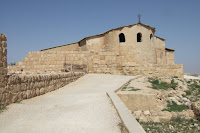
A chamber in the Kerak Crusader Castle
Travel Date 23rd-24th March 2008.
Click on any picture to see a larger version.
Many things surprised me during my short sojourn in Jordan. Of course, they should not have if I had thought about it before arrival; but they did.
Jordan is strategically located on the cross-roads of the world. It is traversed by the trade routes of major civilisations from before the beginning of recorded history. There are remnants of all of those eras but it had not really occurred to me how much history would remain in the form of stone, bricks, mortar and mosaics. In sequence I saw modern Amman, Roman Jerash, early Christian Madaba, Crusader Kerak, ancient Mount Nebo and Nabatean Petra.
Jerash was settled in ancient times but the predominant ruins are from the Roman era of the 1st to the 3rd century AD. The following day I followed the King’s Highway to Wadi Musa and Petra; along the way each of the places I visited was ancient, nearly all had been settled since the dawn of mankind, but each had preserved very different eras for posterity for us to see today.
Madaba, the first town I visited after leaving Amman, also dates back to those ancient eras but the most notable site is the 6th century AD map mosaic in the Greek Orthodox Basilica of Saint George; a rather imposing title for a rather small but very, very old church.
I found later that St George is also an important saint in the Egyptian Coptic Church; something that would probably surprise many Britons who think of him as the patron saint of England.
The mosaic represents a map of the world as it was known at that time. Although I have tried to adjust it for easier viewing, my picture does not do it justice. If you are interested in further information there is an excellent description and history here: A Virtual Travel Through the Madaba map Holy Places.
The town of Kerak is as ancient as the others and also went through Moabite, Nabatean, Greek, Roman, Ottoman and other eras but the Crusader Castle of the 12th and 13th centuries dominates the city. During that period it ruled the district and was effectively the capital of the Crusader region. It was built in the 1140s and despite its size, position and apparent impregnability eventually fell to the Muslims under Saladin around 1189.

Kerak's story at that time was full of blood and treachery, mainly by the Crusaders. It also had occasional quirky moments of chivalry such as the time about five years before it was taken when Saladin was besieging Kerak and he became aware that a wedding was happening in the castle, so he kept his siege engines off the bridal tower.
One of the final rulers, Reynald de Chatillon, became famous for his treachery and brutality before he was deservedly beheaded personally by Saladin. Sometimes I'm very grateful that the "good old days" can never return...
Mount Nebo is most famous from mythical pre-history as the burial place of Moses. The theological scholars can argue about the date for that. However, the re-constructed church on the site dates mainly from the 4th and 5th centuries AD.
The picture is a glimpse of the Dead Sea from Mount Nebo. The model shows a layout of the old churches and sanctuary of Moses on the site. Archaeological and reconstruction work has been continuing since the mid-1930s. As in Madaba there are significant mosaic finds being reconstructed on site; the work is slow and painstaking.


My next post will be on Petra. The wonderful temples and structures carved into the rock at Petra generally date from the late 2nd century BC to the 2nd century AD.
There may be other countries in which such a range of excellent sites representing so many different ancient civilisations could be found strung along a 250km stretch of road, but I doubt there are many. Or maybe that just means I haven’t been to them yet; possibly Israel, or the Lebanon. However, I may wait until those two are on friendly terms with each other before I visit them.
Along the route we covered some surprisingly rugged country including deep ravines. In one of these we crossed a major dam providing power and water. We also saw several nomadic herders' tents beside their flocks.

I arranged my driver through the tour agency in the Commodore Hotel. He got me there and back safely; as a stranger in a strange land you can't ask much more than that.
Cheers, Alan












Alan - Looking forward to your post on Petra. That is the one place while in Jordan that my first wife and I were not able to visit. The fighting in Amman broke out the week that we were planning the trip and wife was evacuated out to Greece and travel was not allowed after that. I was eventually evacuated out to Lebanon and then on to another country.
ReplyDeleteJust happened on your blog while perusing. Great entry on Jordan! Pictures are fabulous! Was there in 2005, and visited pretty much the same spots you did! Would love to see your post on Petra - an absolute favorite of mine. :) Chao!
ReplyDeleteThanks for your comment.
ReplyDeleteIf you would like to read the earlier posts on Jordan they preceded my New Caledonian posts here:
Jordan, City and Country
http://loraltravel.blogspot.com/2009/04/jordan-city-and-country.html
Jerash, an Ancient City in Jordan
http://loraltravel.blogspot.com/2009/05/jerash-ancient-city-in-jordan.html
Darn. Looks like I'll have to do some work. First Bob, now you. I'm going to have to write up Petra now :-)